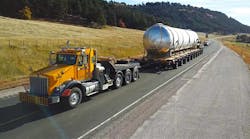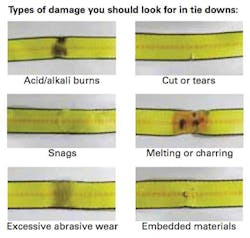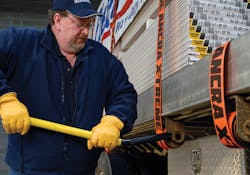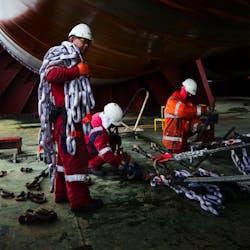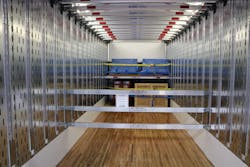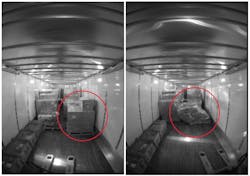Transportation equipment and technology have evolved greatly over the last 20 years, with the focus often on improving the performance of the trucks, trailers, and people involved in moving materials. The last few years have produced many highly sophisticated improvements in the areas of cargo securement and monitoring in both the equipment and software space. These range from stronger webbing material that can replace steel chains and a first-of-its-kind automated trailer decking system to artificial intelligence-aided cameras at the dock and in the trailer that tell workers how to stack boxes in a trailer and provide managers better situational awareness.
Staying abreast of these trends can help fleets and drivers improve several other business metrics, from tightening up Compliance, Safety, Accountability scores to cutting down detention time. To help the industry catch up, here are some of the most innovative equipment trends in cargo monitoring and securement.
Ratchets and straps
The importance of proper cargo securement goes beyond complying with Federal Motor Carrier Safety Administration (FMCSA) rules or even preventing damage to the load and road.
“We’re protecting and saving lives from either serious injuries or even possible death by keeping those loads firmly in place,” said Bob Dissinger, director of U.S. sales for Kinedyne, which provides cargo control solutions. It’s a job Dissinger sees as a matter of life and death, because for him, it once was.
In January 1996, his Buick Century was T-boned by another sedan going 60 mph through a country intersection. That driver had fallen asleep. The Buick flipped a few times before settling upside down, Dissinger recalled. He crawled through a broken window and needed only seven stitches. The reason? He was wearing a safety belt.
“Cargo securement is to cargo what a seatbelt is to a human being,” he explained, which is why he says Kinedyne goes “above and beyond” basic regulations for tie-down tools such as webbing, winch and ratchet straps, and transport chains.
“All too often, cargo control has become very commoditized,” Dissinger asserted, pointing to “dozens and dozens of no-name brands hitting the marketplace.”
When Kinedyne tests these low-cost products, Dissinger said these low-cost products often fall short of current required specifications. But worse is their chance of failing when needed most, such as if the flatbed trailer jackknifes and flops onto its side. Inferior tie-downs may break, and that pallet of bricks could become a salvo of projectiles.
“Is that $10 or $15 you saved worth the life you just cost?” he asked. Fleets looking to go with a cheaper alternative should first break out a scale to see if the new product is as heavy and robust as what they are currently using. “If it seems too good to be true, the first thing to do is take what you’re currently using, weigh it, and then take the new product and weigh it,” Dissinger said.
In 2018, Kinedyne introduced the K-Force and Rhino Max brands that have increased working load limits (WLLs) by adding more polyester material to the straps. In 2017, Kinedyne addressed growing e-commerce demand by introducing load-rated curtainside systems, which laterally restrains cargo, on chassis-mounted truck bodies. The Kin-Slider system opens and closes like a sliding door in 30 seconds with a release mechanism, helping delivery drivers spend less time and energy at each stop. The solution also weighs up to 1,000 lb. less than traditional roll-up systems and saves up to 111 cu. ft. of space.
Tie down systems
“There are still areas of load securement that are still a little bit in the Stone Age,” said Ralph Abato, president and managing director of load securement provider Doleco USA. Abato has served as a member of the Web Sling and Tie Down Association for three decades, having served as its vice president, as well as helping craft the current FMCSA cargo securement rules that have been in place since 2004.
He said one tool that needed a heavy dose of evolution is the winch bar, typically a 33-in. steel bar that acts as a lever to increase or release tension on the winches attached to the bottom of a flatbed trailer.
“There’s a lot of force on those bars, and there’s potential for kickback,” Abato said. These may also be used as a cheater bar for load binders. “It’s just extremely dangerous when those are being released; there’s a hell of a lot of dynamic force on those that have a tendency to come back and hit you in the head,” Abato said.
When he would ask groups at trade shows how many in attendance have been hurt using a winch or winch bar, “almost everybody [would raise] their hand; they’ve all had some injury,” he recalled.
Doleco offers the gear-driven Boa Winch tie-down system that requires very little input and has a 22:1 gear ratio. “That eliminates the need for a long winch bar,” Abato said.
Ancra Cargo offers the Ergo 360 winch bar with an ergonomic grip and mushroom tip to prevent slippage when tightening the tie-down straps, plus a curved design for better leverage. A combination box end model is available that can be used to release tension on load binders, because it extends the typically short binder and keeps the pivot point away from the user’s face and hands.
In the near future, Abato believes tension indicators, used currently in Europe and Australia, will arrive in North America. These provide an accurate measurement of tension, which Abato noted can change as the load shifts during transit.
“It will equalize, but it will equalize at something less than what you initially tension,” he said. “You may have the right number of straps and have them in the right place, but if they’re all loose, then you have a dangerous situation.”
Truckers are supposed to check load tension after three hours or 150 miles, and when using chains, this could present a dangerous situation for the driver. The chain may need to be slacked to loosen the retracted binder, and a load of logs could come rolling down.
This year Doleco released the DoRa ratcheting load binder, which features a compact size and improved tensioning length to its spindle-in-a-spindle ratchet configuration.
“The DoRa’s longer spindles enable drivers to reach farther, so less exertion is required to remove slack from chains during initial tensioning,” Abato explained. “The longer spindles also mean more reserve length is available for periodic chain re-tensioning.”
Doleco has reduced the potential for injury with the DoNova textile chain. Each link comprises several layers of Dyneema, a high-performance webbing as strong as chain-grade high strength steel and 85% lighter. Abato calls Dyneema “a miracle fiber, because it checks off all the boxes of abrasion resistant, cut resistant, chemically resistant, and it floats on water.”
“These allow people to tension the loads without the amount of physical exertion required hauling heavy steel chains up and over the load,” Abato said. “We’ve found workers’ comp claims have been dramatically reduced by reducing the weight, by having a nice, soft, pliable textile chain slung over your shoulder as you’re fixing the load on the trailer.”
These Dyneema chains also can reduce weight by 1,000 lb., improving fuel efficiency and allowing for more material to be hauled as well.
Decking systems
For many years, companies such as Kinedyne have made manual decking systems that employ a series of steel beams on wall tracks to create a second level for pallets as well as keep cargo from sliding forward. They are commonly used by the less-than-truckload (LTL) sector, those that “cube out.”
The problem has been the forklift drivers would prefer to try and lift the beams with the lift as opposed to getting off the vehicle and adjusting them, causing damage to the beams and occasionally the trailer roof. Workers could also be at risk for slips or falls as they climb over boxes to position the beams. Even done right, positioning the deck takes about six minutes.
To address these challenges, Ancra introduced the AutoDeck system. This system automates the beam positioning process to reduce loading and unloading time, and improve overall safety to workers and cargo.
Currently being validated by two customers, one of the solutions comprises 19 beams on a 28-ft. trailer. Operators can position the beams automatically in as little one minute using the control panel at the aft end of the trailer, without physically moving any beams themselves.
Jeff Murillo, Ancra’s director of sales-engineered cargo systems, sees a near future where the sensors, scanners, cameras, and automated equipment across the loading dock ecosystem can all work in concert to create even more efficiencies.
“We think this is the tip of the iceberg,” Murillo said. “Our ultimate goal is for the system’s intelligence to adjust the deck accordingly once the forklift operator picks up the pallet and puts it under the dimensional scanner, before that individual even drives into the trailer.”
Murillo also said dispatch would receive a message as to how much cubic space remains on the trailer. Ancra would need to partner with an industrial Internet of Things provider to fully automate the solution.
Ancra has also already developed a way for AutoDeck to be controlled from a smart device via WiFi. This was demonstrated at TMC in 2019. AutoDeck should be validated by spring and can be built at the trailer body builder or retrofitted. There are existing quotes for a 53-ft. trailer configuration, where the system consumes about 37 ft. of trailer space, according to Murillo.
That system could be delivered to the customer by February. Validating robustness is ongoing, as Ancra targets a 20-year life cycle, and Murillo noted the LTL space incurs a lot of wear and tear.
One of the test fleets, a top logistics provider (that asked to remain unnamed), has used the AutoDeck for about 24 months. The first adopter had previously used Ancra’s manual solution and sees great potential in the precedent-setting technology.
“The advent of increased automation, robotics, cameras, sensors, and potentially autonomy provide new ways of leveraging this technology for loading and unloading a trailer more efficiently, as well as full utilization of space, and can greatly improve operational efficiencies and reduce costs,” said the test fleet’s director of automotive maintenance and engineering.
Trailer visibility
The previously mentioned equipment helps cargo stay secured on the road and helps get it on and off the trailer faster. When paired with cargo monitoring solutions, telematics, and visioning systems, it could be like giving fleet managers and logistics supervisors a cheat code to unlock game-breaking efficiencies. The first of these is called TrailerNet, launched by Phillips Connect Technologies (PCT) in 2019. This hub hooks up wired and wireless trailer components and provides GPS, geofencing, and trailer mileage data, with the ability to add nine more sensors.
Additional sensors can monitor items such as detect the presence of cargo, or if the trailer door is open or closed. With the cargo sensor, carriers can remotely monitor cargo and discern if it is empty or loaded, and the distance to the dock, to potentially identify dunnage so it can be cleared faster, explained PCT general manager Jim Epler.
“Adding telematics to your asset is like turning a light on in a dark room,” Epler said. “Adding a cargo sensor then tells carriers what’s in the room, which yields more ROI [return on investment] and helps carriers in a variety of ways.”
The reason is simple: time equals money. “The quicker carriers can find out when their asset is empty, the quicker they can get another revenue load on the asset,” Epler explained.
This includes knowing what trailers are full of dunnage and need to be cleaned out, which eats up more time. This is an upgrade over the old-school way of sending drivers to perform manual lot checks and finding themselves “chasing empties” in crowded yards as opposed to revenue-generating drivetime.
“Being able to direct a driver to within three meters of an asset saves time,” Epler said. “For example, they do not have to drive through a lot of hundreds of trailers trying to essentially find a needle in a haystack.”
PCT estimated that the cargo sensors alone can provide a 1,000% ROI and identified nearly 100 individual ROI opportunities.
“Carriers can also monitor how quickly a customer loads from the first box until it’s fully loaded—and potentially make better pricing decisions because they have insight into customer behavior,” Epler said. “Images can also help carriers with any claims, recognize theft immediately and proof of detention.”
Freight cameras
Sensors provide part of the story; adding freight cameras offers the whole picture. The lots at manufacturer and distribution centers can be massive and can have hundreds or thousands of trailers. Those trailers embedded with a camera system can let managers know their status.
“Before the trailer gets to the dock, you’ll know if the load has been unsettled and can allocate the additional resources that may be required to resolve the problem,” explained Mark Stanton, general manager of PowerFleet for Industrial, which provides an array of sensors, cameras, and software to better manage logistics challenges.
Stanton also suggested freight cameras, which have an infrared mode, can also identify extra capacity in a trailer and record historical data for future auditing to prove the load left the dock in a “safe, secure, and compliant manner.”
Furthermore, he said the monitoring could keep workers honest as they know they are being watched. On a more positive note, he said the cameras can also indicate when a worker has been especially diligent and deserving of recognition.
Zebra Technologies offers a similar camera solution attached on the facility side as part of its SmartPack solution. Machine visioning software analyzes this visual data to determine how full the trailer is as the workflow progresses.
“At the same time, it’s helping to prescribe what’s going to be the best way to facilitate less air in that trailer,” said Drew Ehlers, global futurist and global general manager of SmartPack within the Office of the CTO at Zebra. “If your typical efficiency rate is around 85%, you may be able to get that in the high 90s.”
Over the course of a day, the saved space could mean one less truck was deployed and could then be reallocated to a new workflow. “The overall effect for carriers is a lot less fuel cost and less trailers used on the road, which also equates to positively impacting their carbon footprint,” Ehlers said.
The artificial intelligence component can also upskill warehouse workers, who, because of the high turnover of the demanding job, do not have a lot of experience properly and efficiently loading trailers. SmartPack creates an overlay of 3D imagery with point cloud data and calculates where the open space is and how the boxes should be optimally stacked. That information is sent to workers to instruct them on how to build a more secure, space-saving composition.
“It’s almost like playing Tetris,” Ehlers remarked, though the big difference is this version is based on hundreds and thousands of customer loads. By relying on that mountain of data, human error can be almost entirely removed, as can the experience deficit felt at the loading area. Versus the typical three-to-six-month growth period to come into that workflow, we’re able to get them up to speed within a week.”
Combining these better trained workers with the previously mentioned securement equipment should ensure that loads get to their destination intact and on time without compromising safety.
